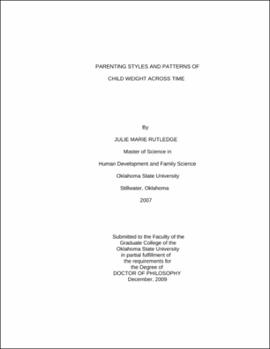| dc.contributor.advisor | Harrist, Amanda W. | |
| dc.contributor.author | Rutledge, Julie Marie | |
| dc.date.accessioned | 2013-12-10T18:04:21Z | |
| dc.date.available | 2013-12-10T18:04:21Z | |
| dc.date.issued | 2009-12 | |
| dc.identifier.uri | https://hdl.handle.net/11244/7712 | |
| dc.description.abstract | Scope and Method of Study: There is a need for longitudinal analyses to identify key factors in the development of childhood obesity. This study sought to examine the links between parenting styles and child obesity across three waves (beginning of first grade, end of first grade, and end of second grade) and further examine the potential moderating factors of gender, socioeconomic status, and ethnicity among a sample of 356 children. Parenting style was assessed by the Parenting Styles and Dimensions Questionnaire. Child obesity was operationalized in two ways: (1) five distinct weight status groups into which children were classified at each wave and (2) nine weight trajectories which accounted for their weight statuses across waves. Quadratic growth modeling, a type of structural equation modeling (SEM) and multinomial logistic regression (MLR) were used to examine parenting styles' potential prediction of these different weight classifications. | |
| dc.description.abstract | Findings and Conclusions: SEM results showed that high permissive parenting significantly predicted higher initial weight than both the average reference group and low permissive parenting. MLR results showed that permissive parenting predicted stability of higher weight across time; specifically, with each increase of one standard deviation in permissiveness, children were 3.5 times more likely to be between the 75th and 85th and 2 times more likely to be between the 85th and 95th BMI-for-Age percentile when compared to children below the 50th percentile. Additionally in SEM, children of high authoritarian parents began at a non-significantly lower weight relative to the average reference group and low authoritarian parents but increased their weight significantly, primarily from wave 1 to wave 2. Contrary to hypothesis, a significant interaction between mother ethnicity and authoritative parenting was found due only to the autonomy granting subscale. Children of Native American mothers with low levels of autonomy granting had the highest initial levels of weight when compared to the average reference group and high autonomy granting parents and increased close to the 85th BMI-for-Age percentile by wave 3. Children of Native American mothers who exhibited high levels of Autonomy Granting significantly increased in weight between waves 1 and 2; however, their average weight did not increase into a risk range. Parenting style appears to play some role in the prediction of child weight longitudinally and this relation is moderated by the ethnicity of the child's mother. | |
| dc.format | application/pdf | |
| dc.language | en_US | |
| dc.rights | Copyright is held by the author who has granted the Oklahoma State University Library the non-exclusive right to share this material in its institutional repository. Contact Digital Library Services at lib-dls@okstate.edu or 405-744-9161 for the permission policy on the use, reproduction or distribution of this material. | |
| dc.title | Parenting styles and patterns of child weight across time | |
| dc.contributor.committeeMember | Hubbs-Tait, Laura | |
| dc.contributor.committeeMember | Larzelere, Robert E. | |
| dc.contributor.committeeMember | Page, Melanie C. | |
| dc.contributor.committeeMember | Topham, Glade L. | |
| osu.filename | Rutledge_okstate_0664D_10712.pdf | |
| osu.accesstype | Open Access | |
| dc.type.genre | Dissertation | |
| dc.type.material | Text | |
| dc.subject.keywords | ethnicity | |
| dc.subject.keywords | gender | |
| dc.subject.keywords | obesity | |
| dc.subject.keywords | parenting | |
| dc.subject.keywords | parenting style | |
| dc.subject.keywords | ses | |
| thesis.degree.discipline | Human Environmental Sciences | |
| thesis.degree.grantor | Oklahoma State University | |
